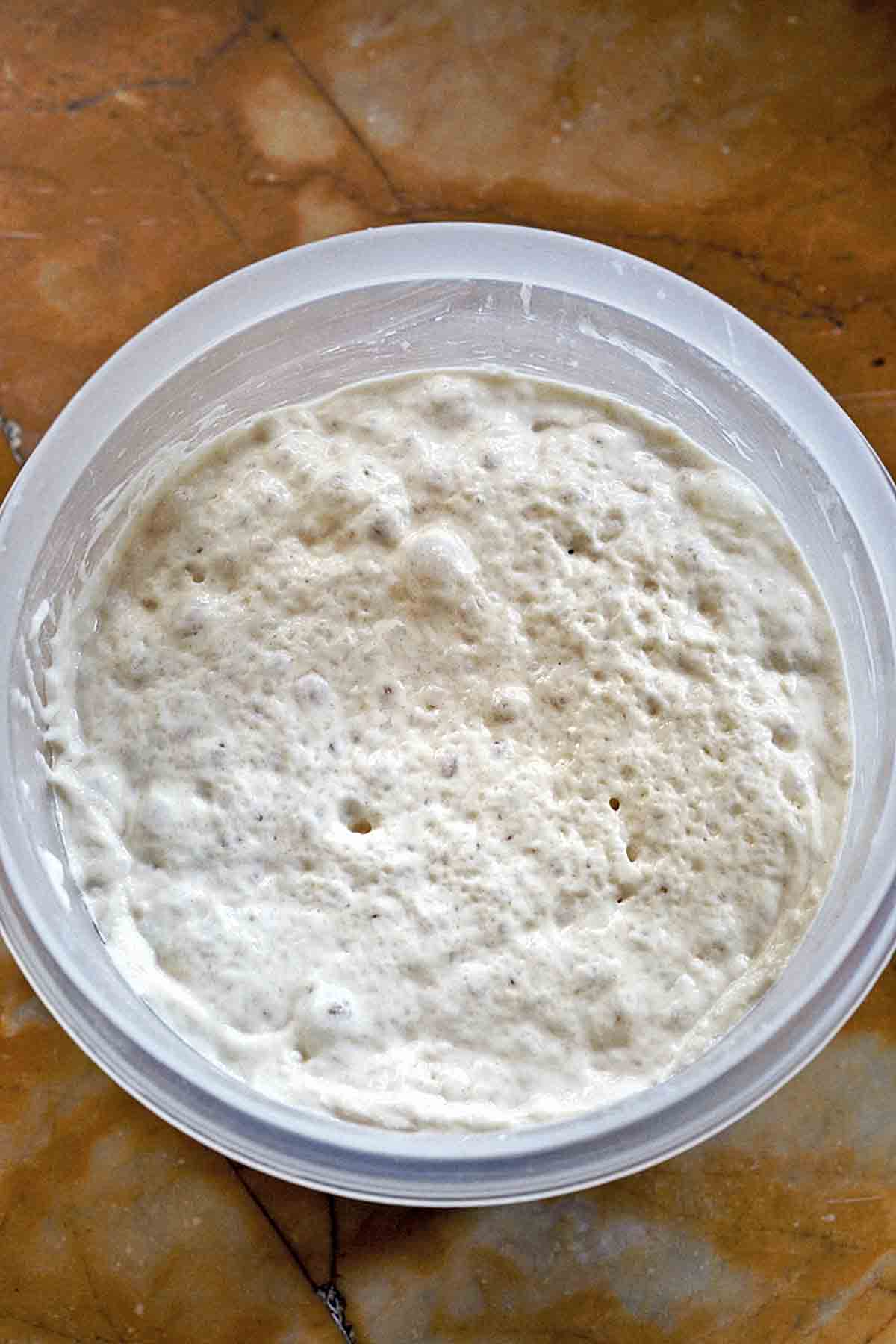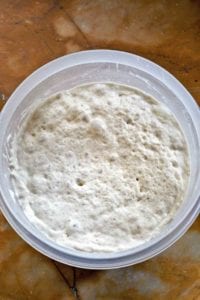
Many of the recipes for classic regional breads, such as this ciabatta recipe, begin with a starter dough made from small amounts of flour, water, and yeast allowed an initial fermentation. The starter, known as biga in Italy, or bighino when in small amounts, not only gives strength to what in Italy are weak flours, it also produces a secondary fermentation from which come the wonderful aroma, natural flavor, and special porosity of the final loaves and wheels of bread.
The important point about a biga is that the breads made with it develop a wonderful taste because their risings are long and bring out the flavor of the grain. Another benefit is that the loaves remain fresher and taste sweeter than those made with large amounts of commercial yeast.
In Italy, bakers use dough from the previous day’s baking to start a new dough. I keep some starter on hand at all times; by having it around, I can decide to make pane pugliese or ciabatta in the morning and have it for dinner that night. Because the first biga must come from somewhere, though, you may make it following the instructions below. It’s remarkable. It freezes very well and needs only about 3 hours at room temperature until it is bubbly and active again, or it can be refrigerated for up to 5 days.–Carol Field
LC Obliged to Biga Note
Behind each and every memorable bite of proper Italian bread we’ve daintily nibbled, hungrily inhaled, or otherwise somehow consumed, we have a biga to thank. So we’re feeling much obliged to Carol Field for this recipe. Nonna not included.

Italian Biga
Ingredients
- 1/4 teaspoon active dry yeast
- 1/4 cup warm water, 100°F to 110°F (38°C to 43°C)
- 3/4 cup plus 4 teaspoons bottled spring water, at room temperature (You can use tap water in a pinch.)
- 2 1/3 cups unbleached all-purpose flour
- vegetable oil, for the bowl
Instructions
- Stir the 1/4 teaspoon active dry yeast into the 1/4 cup warm water and let stand until creamy, about 10 minutes.
- Stir the 3/4 cup plus 4 teaspoons bottled spring water into the creamy yeast mixture, and then stir in the 2 1/3 cups unbleached all-purpose flour, 1 cup at a time. ☞ If mixing by hand, stir with a wooden spoon for 3 to 4 minutes. ☞ If mixing with a stand mixer, beat with the paddle at the lowest speed for 2 minutes. If mixing with a food processor, mix just until a sticky dough forms.
- Transfer the biga to a bowl lightly coated with vegetable oil, cover with plastic wrap, and let rise at cool room temperature for 6 to 24 hours, until the starter is triple its original volume but is still wet and sticky. (The bakers I admire most advise 10 to 11 hours for the first rise, but others are very happy with the 24 hours it takes for dough to truly become yesterday’s dough, and if you like sour bread, allow your biga to rest for 24 to 48 hours or even 72 hours.)
- Cover and refrigerate or freeze the biga until ready to use. (If refrigerating the biga, use within 5 days. If freezing the biga, let it rest at room temperature for about 3 hours until it is bubbly and active again.) When needed, scoop out the desired amount of biga for your recipe and proceed. I strongly recommend weighing the biga rather than measuring it by volume since it expands at room temperature. If measuring by volume, measure chilled biga; if measuring by weight, the biga may be chilled or at room temperature.

Nutrition
Nutrition information is automatically calculated, so should only be used as an approximation.
Recipe Testers’ Reviews
This is a perfectly suitable starting point for most any bread which uses a starter. I bake bread several times a week and it’s nice to have this handy. Sometimes I add this to a bread dough which doesn’t call for a starter just for the added flavor.












I have a quick question. I live in a very dry climate and I have used this recipe twice now, and the Biga doesn’t seem as wet as it does in the picture. Should I be adding more water? Just how wet does it need to be?
Hi Mahbaker, since the biga is covered with plastic wrap (which is pretty good at sealing in humidity for a short period such as this recipe requires), it is unlikely that a drier climate would make any difference. It might be the amount of flour. Just to be super accurate, I would suggest using a scale for your measurements. The biga and the dough are quite dependent on the proper hydration level for their texture, as is the resultant ciabatta. The technical answer to “Just how wet does it need to be?” is 79%, which a bit difficult for quantify. You might also want to check the protein levels in your flour as sometimes a very high protein flour it could absorb more of the water and appear drier.
Thank you!! I have started having a better success rate and I’m sure it will be perfect in no time.
Wonderful news Mahbaker!
I have just started baking bread a few months ago, and have been mainly sticking with the ‘no-knead’ method of baking, and this whole time I didn’t realize I was making biga. Curious tho, how long can you freeze it for? Not that I plan to have it in there for more than 2 weeks tops. I’d like to try this with your ciabatta recipe, but I have neither a food mixer nor food processor, and it sounds messy otherwise.
Hi Bobba Ganoosh (love the name, btw) I spoke with Cindi our baker extraordinaire to get some answers for you. This is her advice “There’s a little difference between no-knead and biga in that the biga contains no salt. Yeast dough freezes very well. I don’t do it often because these lean doughs also keep well several days in the refrigerator and that’s easier to me. That is essentially what the whole book Artisan Bread in Five Minutes A Day is about. When I do have too much to use or a change of plans, I oil a freezer bag and slip the dough in, double the bag, flatten it out a little (defrosts faster) and freeze for up to 3 months. I think the dough is best used within a month. It loses a little rise, but for the most part the yeast survives intact and the bread made with it should not be noticeably different.
Although the recipe for ciabatta recommends against making it by hand there really isn’t any reason not to. After all this bread was made, as well as other classics that we use machines for today such as brioche, successfully long before the invention of modern appliances. True, it’s a very wet dough and can be awfully messy/sticky, so I’d suggest the aid of a dough scraper. A light coating of oil on your hands may help too. Worst case is a little too much flour gets added and the loaf is a bit denser, less full of those gorgeous holes, than traditional ciabatta. Not a big downside risk.
Hope this helps!
I really want to give this a go but it’s hard to find a cool room temperature nowadays. What happens if it is left out in a warm room? Or can I put this in the refrigerator for the initial 6-24 hours? I don’t want to wait until the fall to eat this! Thanks!
Hi Suzanne, I checked with Cindi (our super duper baker) and this is her advice “When I made this the other day I actually had it at un-airconditioned room temp for about 6 hours then stashed it in the frig overnight. It worked fine. My room temp wasn’t that hot, but definitely there is a difference when this is made in the summer. Doughs ferment differently, not just faster, at higher temperatures, more yeast action less bacterial. If the room is over 80 degrees I’d suggest leaving it only a few hours, then refrigerating overnight. There’s little risk in keeping it at cooler temperatures. Although, frankly, I doubt there’s much problem with even a very warm room temperature (90) for 6 hours for the biga since there’s no added fat or sugar. I proof starters at school in a proof box sometimes (90-95) when I need to get them active quickly since our class isn’t long enough to allow the proper time at room temp. It’s not my preferred method because it doesn’t allow for maximum flavor and texture development, but it doesn’t hurt the yeast. And, as you know, I stash Lex (fyi “Lex” is her beloved sourdough starter) in the refrigerator indefinitely. I don’t think there’s any reason to hesitate just because it’s summer and the kitchen’s warm. Leave it out for the full 24 hours and it may develop a slightly more sourdough flavor, which is not necessarily a negative in any case. I can’t see any harm in a 6 hour rise at summertime room temps.”
Hope this helps, can’t wait to hear about your summertime version.
I live in the tropics with an average daily temperature of 27 to 34C so my biga is always refrigerated after 4 – 6 hours room temperature fermentation.
Actually, to be precise, I use poolish (100% hydration) for both ciabatta and Sfilatino.
Thanks Peter!